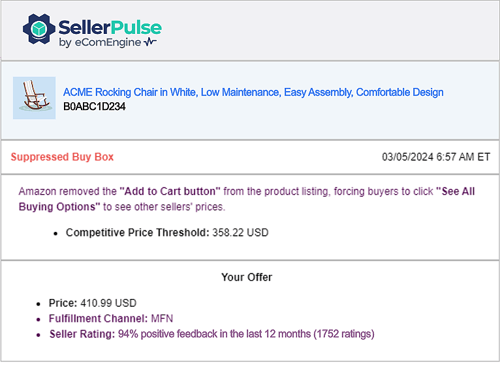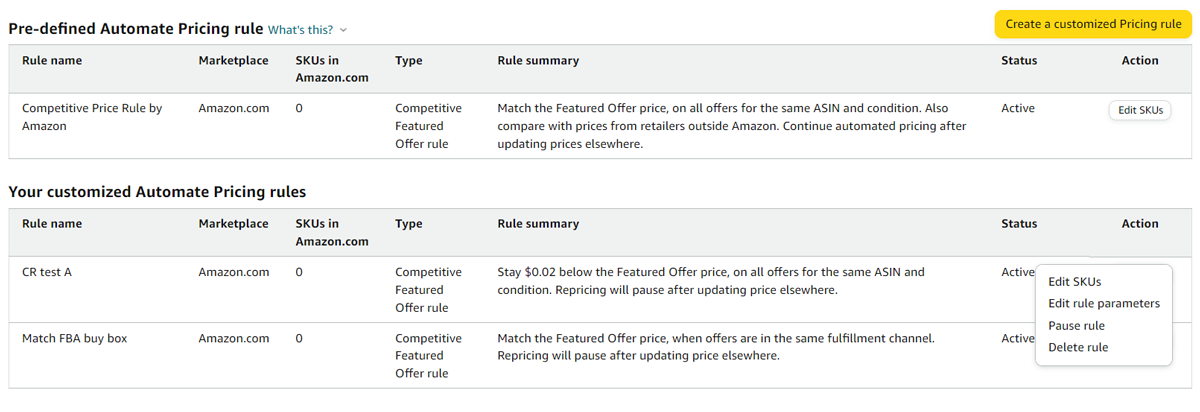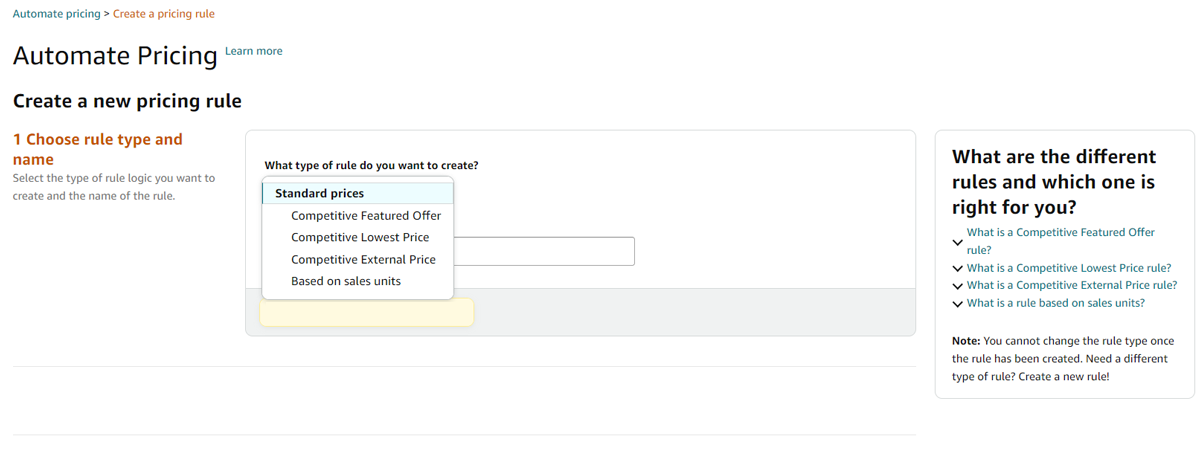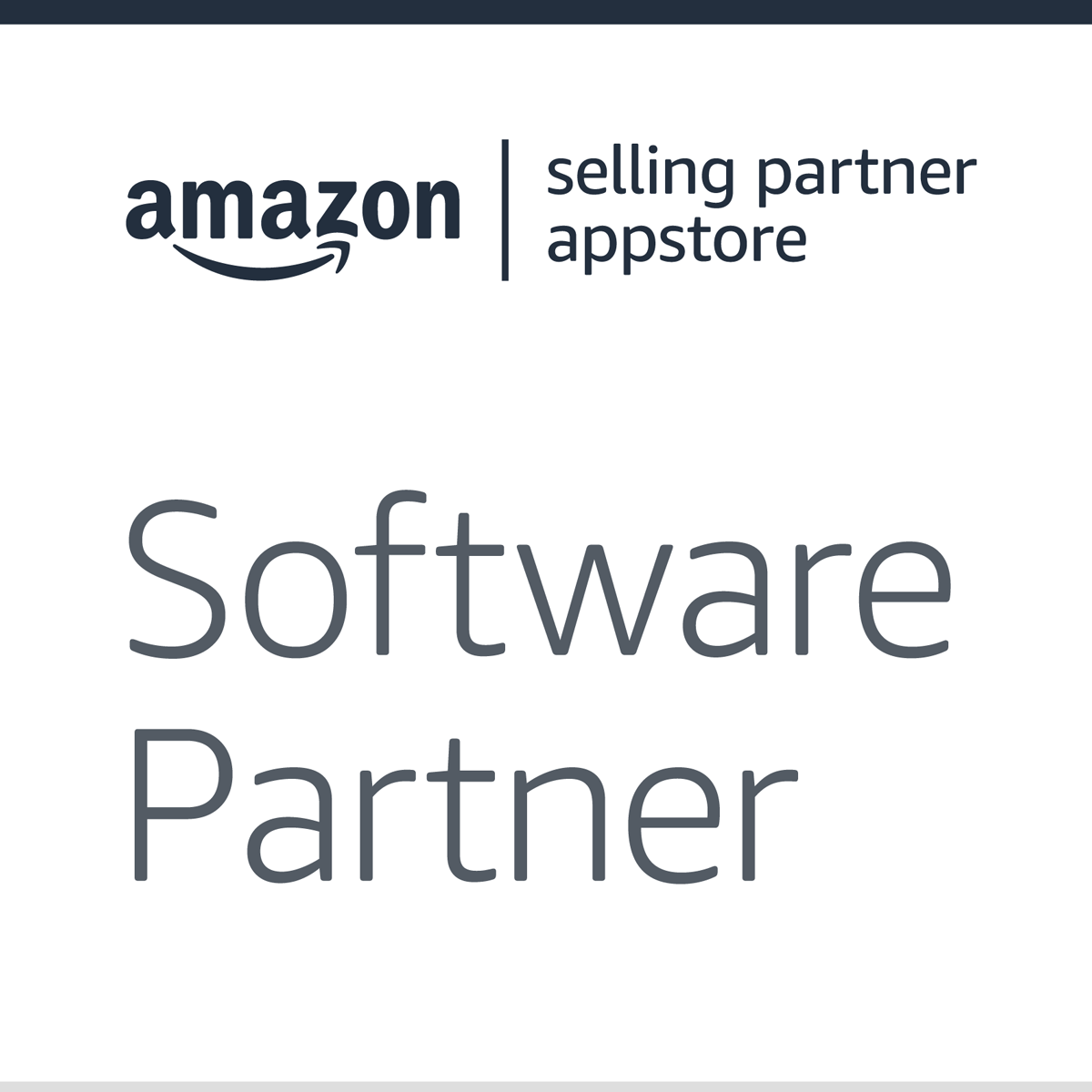Menu
Join Our Email List
- Receive our monthly newsletter.
- Stay up to date on Amazon policies.
- Get tips to grow your business.

Keeping your Amazon pricing competitive is key to winning the Buy Box (also referred to as the Featured Offer), which leads to increased sales. A higher sales volume brings you more opportunities for success, from additional cash flow that allows you to capitalize on new opportunities to stronger negotiation power with your suppliers.
You work too hard to undersell your products. There's a fine line between staying competitive on the one hand and getting stuck in a money losing race to the bottom on the other. Having a smart Amazon pricing strategy in place means finding the right balance of maximizing your profits while selling steadily.
Ultimately, your pricing strategy should enable your Amazon business to continue to grow. Increased cash flow gives you the power to make decisions that can save you money or increase brand awareness. For example, placing larger orders with your suppliers may win you a special discount from them or implementing an advertising strategy might net you more sales. Hiring an additional team member, improving packaging for a better customer experience, and sourcing new products all require capital.
While pricing and pricing strategy can be (and often should be) product specific, both begin with your business goals. Ask yourself questions like:
Regardless of where you want your Amazon pricing strategy to take you, it starts with some simple math. You should know your acceptable margin and understand the costs associated with each product you sell, from manufacturing to delivery. If your product has a limited shelf life due to seasonality or category (such as grocery or beauty), be sure to factor that into your pricing strategy and have a plan for moving excess inventory.

My pricing strategy begins when I buy products. I am a huge fan of exclusivity agreements with my suppliers as it then avoids any pricing degradation (aka “race to the bottom"). I love bringing new products to Amazon. Couple this with exclusivity agreements and I don’t have to worry about other sellers tanking a price. When I can’t get exclusivity agreements, I pay attention to the other sellers that are on an existing Amazon listing. I stay away from products where the competition are known to push prices down past profitability.Charlene Anderson

Learn how your Amazon pricing strategy affects your business.
Let’s face it, we all love a good deal. Amazon shoppers are no exception. They’ve come to expect great prices, fast shipping, and amazing customer service. As eCommerce becomes more ubiquitous, so do price comparisons. Amazon wants you to provide the best possible price for its customers, so competitive pricing is an important factor in the Buy Box algorithm.
Big box stores like Target and Best Buy have been matching competitor prices for years. eCommerce has simply led the charge in digitizing the price-matching process. Now browser extensions, apps, coupon sites, and comparison content help shoppers find the products they want at a bargain price. Comparing prices and features has never been easier for consumers.
But attracting customers isn’t all about having the lowest price. Here are several other factors that shoppers consider when making a purchase decision.
 On Amazon, sellers frequently change their prices to compete more effectively. It’s not uncommon for prices to shift multiple times per day for popular items. Product prices often shift due to changes in item cost, shipping costs, demand, shopping trends, and other factors. For this reason, remaining competitive can be challenging.
On Amazon, sellers frequently change their prices to compete more effectively. It’s not uncommon for prices to shift multiple times per day for popular items. Product prices often shift due to changes in item cost, shipping costs, demand, shopping trends, and other factors. For this reason, remaining competitive can be challenging.
Your product pricing depends on several variables, but it’s important to consider how you compare to your competition. If you offer faster shipping or have a better feedback rating, you may get the Buy Box without having the lowest price. The number of sellers for the ASIN also impacts pricing. For example, if demand is high for an item with only a couple of sellers, you can almost certainly maximize your profits. On the other hand, low demand for a product with numerous sellers means you might need to sell at a lower price. You may choose to raise or lower your price depending on your true cost, demand, advertising strategy, and other factors.
In addition to staying competitive, you’ll also need to balance supply and demand. In many cases, sellers leave money on the table by pricing just above or matching the current lowest price for an ASIN. When supply begins to wane and competitors begin running out of stock, it makes sense to raise your price while the item is in demand. Seasonal items often increase in demand during specific seasons; during those times, it is important to have a sense of the competitive field and how you fit into it. Understanding when to raise and lower your price is an intricate art. Repricing ASINs is often the most effective way to stay in the running and get a share of the Featured Offer.
The Similar Products dashboard in Seller Central shows you price comparisons for items customers may consider when shopping for your product. It helps you find similar products and monitor prices so you can make informed pricing decisions.
 Monitor your performance in the Buy Box closely to succeed on the Amazon platform. By gaining a comprehensive understanding of the key factors that contribute to winning the Buy Box, you can implement effective strategies to stay competitive. Quick response to any loss of the Buy Box, whether through adjusting your prices or optimizing your inventory management, is crucial for maintaining consistent visibility with customers on the platform.
Monitor your performance in the Buy Box closely to succeed on the Amazon platform. By gaining a comprehensive understanding of the key factors that contribute to winning the Buy Box, you can implement effective strategies to stay competitive. Quick response to any loss of the Buy Box, whether through adjusting your prices or optimizing your inventory management, is crucial for maintaining consistent visibility with customers on the platform.
SellerPulse by eComEngine provides alerts for two types of Buy Box events: lost and suppressed Buy Boxes, where your offer loses the Buy Box to another seller or Amazon, or the Buy Box is completely suppressed; and won Buy Boxes, where your offer wins a Buy Box that another seller or Amazon previously held. These alerts also offer valuable information about the current Buy Box winner, including the product price, seller ID, and seller rating. SellerPulse even alerts you to the competitive price threshold that caused the Buy Box to become suppressed. It also offers a detailed Buy Box report with insights to help you understand how your products are performing.

Here's an overview of some of Amazon's most important pricing guidelines.
In many product categories, you will have the option to supply a reference price. This might be a list price or a manufacturer’s suggested retail price. If you provide a reference price, Amazon requires it to be a price at which you or other sellers have recently made substantial sales of the item. Reference prices provided to Amazon must stay current. If Amazon cannot verify your provided reference price, it may be suppressed.
Amazon allows you to list items at any price that you feel is fair as long as it complies with the reference price policy and certain limitations. For example, if you are on the Individual selling plan, you may not list items at a price higher than $10,000. Sellers on the Professional selling plan cannot list items at prices higher than $300,000. There is an exception for collectible items.
In order to maintain fairness for sellers and protect the shopping experience for customers, Amazon reserves the right to process a limited number of price updates in a single day. If you reach the maximum daily allotment of pricing updates, no further updates will be processed until the next day.
The Pricing Health page is not a policy, but it is useful to understand. Found in Seller Central, it shows all of your offers that are currently ineligible to be a Featured Offer/Buy Box winner because they are not competitively priced when compared to retailers outside of Amazon. You can resolve the issue by changing your offer's total price (including shipping) to at or below the competitive price.
Amazon monitors prices on its marketplaces as well as other marketplaces. This includes shipping costs. If Amazon perceives that your pricing practices are negatively impacting consumer trust, you may experience one of the following consequences: removal of the Buy Box, suspension of the ship option, removal of the offer, or even suspension/termination of your selling privileges.
Amazon outlines the following pricing practices that harm customer trust:
When pricing your products, be sure to adhere to the fair pricing policy. Always consider how the customer will view your pricing. If a reasonable customer would take issue with your pricing, Amazon probably will too.

Minimum and maximum prices are an important part of your Amazon pricing strategy. Establishing an acceptable price range for your products helps you operate more effectively and avoid possible policy violations with Amazon.
Having a minimum price prevents you from selling your item for less than you intend to. If you’re not careful, you could quickly find yourself losing money for the sake of beating a competitor or increasing sales volume. Sometimes this strategy might make sense for your business in the short term, but it’s not sustainable. Deciding on minimum prices for each of your products is an important part of running your business effectively. If finance isn’t your cup of tea, hire someone you can trust to help you.
1. Your total cost per unit, including, but not limited to:
2. The minimum profit per item you’re currently willing to accept for this product.
Adding this all together will result in your minimum price for this item. Note that your desired profit may be quite different for different products. It may also change for the same product over time. As your desired profit margin changes, it is critical to remember to update your minimum price. Also, consider leaving space in your margin for future discounts and promotions to avoid selling at a loss while offering a deal.

Understanding your product cost is vitally important. First you must understand how much gross margin you are receiving on each product. That determines how much you have available to fund advertising and other marketing costs as well as your operating costs. I recommend people build profit into their product evaluation. If you can’t achieve a high enough sales price to cover landed costs plus profit at 30% plus advertising and operating expenses, then pass. That product will typically only go down in sales price over time and you will be left trying to figure out how to pay for everything."Cyndi Thomason
You might wonder why you need to bother setting a maximum price. After all, the higher your product sells, the better. Right? Well, not exactly. Setting a maximum price is important because it allows you to avoid something called price gouging. Price gouging occurs when a seller increases pricing to a level that is much higher than what is considered fair or reasonable. This usually happens after a sudden increase in demand. You may recall news stories about this regarding high prices on bottled water and other supplies when Hurricane Dorian struck Florida in fall 2019, and again with medical supplies during the coronavirus outbreak.
Sellers are required to set fair prices within the limits set by Amazon. Your price must also align with Amazon’s reference prices policy. Having a maximum price in place prevents you from accidentally breaking the law or Amazon policy by price gouging. We’ll cover these policies in the next section.

There are many approaches to setting prices for your Amazon products. Let's take a quick look at a few of the more popular methods.
If you’re an FBA seller with stellar account health who wants to get the best profit possible on every sale, you may want to price higher than your competitors. It is possible to get the Buy Box without the lowest price. Seller health, shipping time, and other factors play a role in determining which seller has the Buy Box.
Matching competitor prices can be a good way to get a share of the Buy Box rotation without digging into your profit margin too much. With this strategy, you simply match the prices set for your ASIN by competitors.
Pricing below your competitors might seem like a surefire way to win the Buy Box. However, the Buy Box algorithm is complex and considers a variety of factors, not just price. Even if being the lowest priced offer is the only way to win a particular Buy Box, if you are pricing under a competitor who is trying to price below you, it can quickly become a race to the bottom.
On the other hand, this strategy can be helpful if you are trying to sell through inventory quickly to free up space for new inventory or avoid additional storage fees. If your Amazon seller health is suffering, lowering your price temporarily to increase order volume may be beneficial. More sales also provide more opportunities for seller feedback and product reviews.
Amazon allows you to offer coupons and discounts for your products. This is often most successful when combined with an advertising campaign designed to drive traffic to your listing, but offering a coupon or discount can also help your listing stand out from the crowd when a customer finds it in a general search. Be careful not to price below cost when discounting a product unless it is a strategy for moving inventory.
This approach is not recommended. Even if you are the only seller of a private label or white label ASIN, having a pricing strategy will help you make the most of high demand and sell more during slow periods. If you sell an ASIN with several competitors, you will likely be left waiting behind the starting line if you are not actively repricing the product.
A more sophisticated approach to creating your pricing strategy is to implement an algorithmic repricing tool. The right tool can help you compete smarter and faster without sacrificing your profit margin. A data-driven approach removes emotion from repricing, helping you avoid pricing wars that hurt your bottom line. It also works around the clock to continuously reprice your products to stay competitive. Read on to explore how different types of Amazon repricers work and learn why algorithmic repricing is so effective.

Amazon repricing shouldn’t be done randomly.
Competing effectively on price is a delicate art and science, especially when it comes to maximizing your profit margin. There are a few different ways to reprice your products: manual repricing, rules-based repricers, and algorithmic repricing tools.
If you’re using a third-party repricing tool, you’ll enter your Amazon Seller ID during setup. This allows the tool to import your account and listing information from Amazon. The tool will sync with your products via an integration with Amazon. This notifies your repricing tool when there are competitive pricing changes for any ASIN you have listed. Your Amazon repricer then makes adjustments automatically.
We’ll skip the technical details here, but it’s good to have a general understanding of how Amazon repricers work. Below we’ve outlined four options for repricing your ASINs.
 If you only have a couple of SKUs or are just getting started selling on Amazon, manual repricing might work for you. To get started, go to the Pricing Dashboard in Seller Central to see if you're losing the Buy Box for any of your ASINs. If you are getting the Buy Box, great! If not, you'll need to do a little research to see how other sellers are pricing the item. Then, you'll adjust your pricing. You can do this by updating one item at a time on the Manage Pricing page. You also have the option to quickly price-match the current lowest price. (Of course, this may result in lost profits for you, based on a variety of factors discussed elsewhere on this page.) You can also manually change your price on the Manage Inventory or Pricing Health pages.
If you only have a couple of SKUs or are just getting started selling on Amazon, manual repricing might work for you. To get started, go to the Pricing Dashboard in Seller Central to see if you're losing the Buy Box for any of your ASINs. If you are getting the Buy Box, great! If not, you'll need to do a little research to see how other sellers are pricing the item. Then, you'll adjust your pricing. You can do this by updating one item at a time on the Manage Pricing page. You also have the option to quickly price-match the current lowest price. (Of course, this may result in lost profits for you, based on a variety of factors discussed elsewhere on this page.) You can also manually change your price on the Manage Inventory or Pricing Health pages.
To manually manage repricing effectively, you or one of your employees will need to go through this process several times a day. It involves a lot of data entry and calculations to determine minimum and maximum pricing. Keeping focused on the bottom line can be tough if you get involved in a price war and want to “win” against your competitor. There is also a lot of room for error, especially as you get tired. In short, manual repricing might work for a little while, but it can quickly become a challenge, which is why many Amazon sellers turn to automated solutions.
You can set repricing rules within Seller Central using the Amazon Automate Pricing functionality, which is included for sellers with a Professional selling account. Amazon automated pricing is pretty simple: choose the pricing rule that suits your business objectives and select the ASINs you'd like to enroll in Automate Pricing.
Amazon Automate Pricing generally works by lowering your price beyond those of your competitors. That's great for customers, but not for your bottom line. Automate Pricing does an excellent job of lowering prices, but it won't help you maximize your profit. It is also less nuanced than an algorithmic repricing tool.

In October of 2022, Amazon made it possible to set minimum and maximum prices for your listings in bulk, which was a nice (and much-needed) update. You may now also use the tool to increase your price when its external price increases and there are no other offers for the same product in Amazon's store that meet your rule criteria.
You can use the Automate Pricing feature to create custom pricing rules for your ASINs as needed. You cannot change the rule after creating it, so if you need to use a different rule, you'll need to create a new one.

Rules-based pricing tools allow you to select pricing rules that align with your goals. By automating the process of repricing your ASINs, these tools save time. Due to the structure of the approach, you must be prepared to reevaluate your pricing rules regularly. Failure to do so could negatively impact your bottom line. For example, if all of your competitors increase their prices due to increased demand, you may run out of stock quickly while selling at unnecessarily low margins.
There are some additional limitations to the traditional rules-based repricing approach. You may find your products stuck in a race to the bottom. You could be losing profits by consistently selling just above your minimum price. Sure, your order volume increases, but if you’re constantly operating on a razor-thin margin, it is difficult to grow your business. You need a solution that will intelligently and automatically price your items based on the competitive landscape.
Many experienced sellers prefer to keep a single source of truth for all cost data outside of Seller Central by using third-party Amazon repricing software. Third-party solutions typically provide more robust functionality than Automate Pricing. Including exact cost information in Seller Central could result in even lower margins, as the tool encourages sellers to price-match the current lowest price. Another benefit of a third-party tool is the ability to keep all cost information in a single location, which makes it easier to make decisions about what to restock, when to raise prices, and more.
Keeping cost information in a single location makes it easier to make decisions about what to restock and when to raise prices.
Smart sellers who want to maximize profits rely on third-party algorithmic solutions such as Aura, which are the best in the business. (Aura even integrates with RestockPro by eComEngine to keep your costs consistent across your repricer and replenishment software!) Algorithms work for you to automatically determine the best possible price for your products based on the competition, your chosen minimum/maximum prices, and other data points.
A quality algorithmic FBA repricer will automatically calculate all Amazon fees and allow you to enter all of your costs for each product, giving you a complete view of the financials of your product. Once you’ve entered your product information, the algorithm constantly works to optimally price any product you list on Amazon, without having to store your product information in Seller Central. It keeps your pricing competitive, allowing you to grab a bigger share of the Buy Box.

Competitive repricing is the most challenging aspect of selling on Amazon. It seems there is no rhyme or reason for who gets the Buy Box anymore. Strategies that work in one category will most likely not work in another category. And even individual items within a category may require a different approach. It is imperative as a smart seller to constantly reevaluate your repricing strategy to stay competitive in this market."Chris Anderson

See why an algorithmic repricer can help you run your business more effectively.
You’re busy. You simply don’t have time to stress out about price wars for each of your ASINs, and, let’s face it, that wouldn’t be the best use of your time. Algorithmic repricing gives you peace of mind by automating a time-consuming task with data science. Maximize your profits without losing sleep or spending hours manually changing prices for each of your ASINs.
Sometimes your emotions get the best of you. Getting caught up in a competitive pricing battle on one of your ASINs is not the best way to use your time and energy. Automated repricing allows you to step away and be a better competitor. By taking your feelings out of the equation, you can be confident that your products are selling at the best possible price while you focus on other tasks.
Keeping up with the constant Amazon pricing changes for your products could easily become a full time job, but even then it is nearly impossible to manage. Algorithmic repricing allows you to automatically list your products at the right price to remain competitive. By monitoring competitor prices and automatically adjusting your prices in response to pricing changes made by rival listings, an algorithmic repricer can help you compete more effectively.
Whether you're hoping to sell through stale inventory or maximize your profit on a popular ASIN, an Amazon algorithmic repricing tool is on the job all day, every day. There are no breaks or sick days. You can rest well knowing that your repricing tool is working for you all day, every day.
14321 Winter Breeze Drive
Suite 121 Midlothian, VA 23113
Call us: 800-757-6840





Copyright© 2007-2025 eComEngine, LLC. All Rights Reserved. eComEngine®, FeedbackFive®, RestockPro®, and SellerPulse® are trademarks or registered trademarks of eComEngine, LLC. Amazon's trademark is used under license from Amazon.com, Inc. or its affiliates.